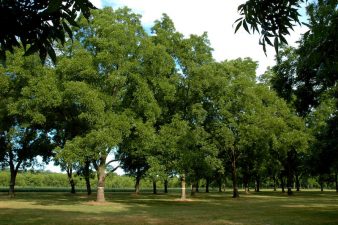
A Brief History of Native Pecan Production in Kansas
We just finished up harvesting, cleaning, and marketing our 2017 native pecan crop. At this point in the season, I usually take stock of how our natives performed during the previous growing season and then make plans for how we can tweak our management program to optimize the 2018 crop. Do we need to alter...
Read more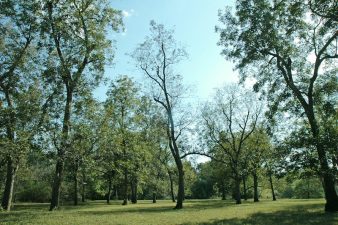
A Short Drive, A Chance to Scout the Native Crop
I was driving along backroads through native pecan groves when I came across a stopped pickup and a guy standing out in the middle of the road with a pair of binoculars trained on the upper branches of nearby trees. Turns out, I interrupted a pecan buyer trying to get a feel for the nut...
Read more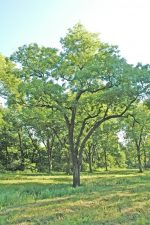
The Story of a Good Native Nut
I don’t think I’ve ever visited a native pecan producer that doesn’t have a favorite tree in their grove. More than likely, he has propagated additional trees of the family’s favorite native pecan with the dream he’s discovered the next big pecan cultivar. I’ve seen a lot of these nuts and they seem to have...
Read moreThe Tree Signals the Timing for Orchard Tasks
“When do I fertilize?” “When do I spray for casebearer?” “When do I control pecan weevil?” These are just a few of the ‘when’ questions I field every year from both new and experienced pecan growers. And with an early spring this year, everyone seems confused about timing orchard operations. I could reply with a...
Read more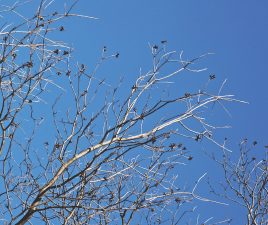
Gauge Native Potential by Branch Growth Pattern
The winter months are usually a time to wrap up marketing last fall’s pecan crop and get ready for a new pecan season. But recently, I took a short drive down the gravel roads in the Neosho River bottom to take a look at native trees in mid-winter. Along the road, I passed native groves...
Read moreInvest in Your Native Pecan Trees
All too often I hear native growers complain that they have little or no crop because wet weather in the spring prevented pecan pollination. The truth of the matter is that a few rain storms during pollination rarely prevent nut set in native groves. When someone complains about lack of pollination, I immediately suspect the...
Read more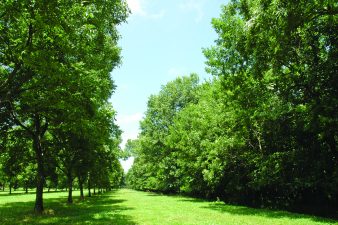
Be Aware of Edge Effects
The other day I was up at our local pesticide distributor to pick up some chemicals when I got into a conversation with a neighboring row-crop farmer. The topic of deer damage came up, and he mentioned that every year deer create the same unique browse pattern along the edges of his fields. That simple...
Read more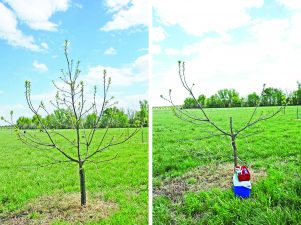
Bark Grafting in the Native Grove
Most native pecan growers have areas in their groves that have dozens of young trees along fence rows or popping up in open areas among mature trees. Fence-line pecan trees are often moved using a tree spade into open areas of the grove to help fully utilize available land area. The bottom line is that...
Read more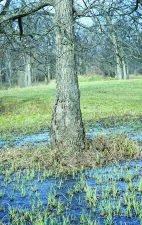
The Causes of Lower Trunk Swelling
I have visited many native pecan groves over the years and have always found at least one tree in each grove that has developed a swollen, disfigured lower trunk. Trees with this condition are typically weak nut producers and often suffer from significant limb loss. As I work with growers to improve their native groves,...
Read more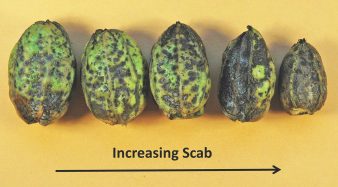
Thinking About Scab at Harvest Time
By mid-September, the limbs of our native trees were bending down under the weight of an excellent nut crop. But it wasn’t until the leaves fell in early November that I could really see the size and quality of the 2015 crop. Back in 2012, extended drought shrank the size of our native nuts causing...
Read more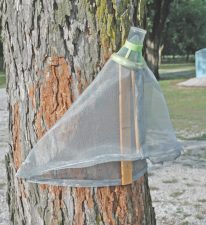
Building Pecan Weevil Circle Traps
Pecan weevil is the number one pest of native pecan growers. Knowing when to spray for this pest is critical for achieving economic control of a weevil population. To help make weevil spray-date decisions, we have been using trunk-mounted ‘Circle’ traps. When placed on known “weevil trees,” these traps are very effective for monitoring pecan...
Read more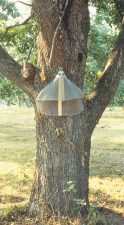
Native Pecan Management During an “On” Year
In many native pecan groves, 2014 was a short crop year. A late spring frost in April 2014 damaged emerging buds and limited pistillate flower production. Then, just as the harvest season began, the weather turned crazy. We started with snow in early November then had periodic rain and snow storms during much of the...
Read more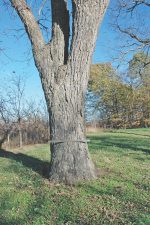
Native Pecans: a history of tree growth and yield
One of the jobs I look forward to each fall is shaking trees in our native grove. Driving from tree to tree with the shaker gives me the opportunity check tree health, and as I shake the tree, the sound of nuts hitting the tractor’s roof gives me a good feel for this year’s production....
Read more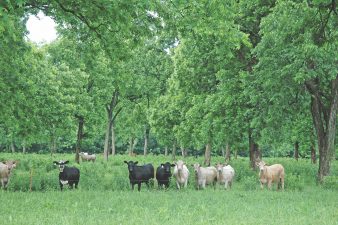
Impacts of grazing cattle in a pecan grove
One of the most common forms of ground cover management in native pecan groves is to pasture cattle (Fig. 1). Grazing offers 2 advantages for a pecan producer: a second source of income from the same parcel of land (pecans + beef) and a significant reduction in orchard mowing costs. The grazing of animals under...
Read more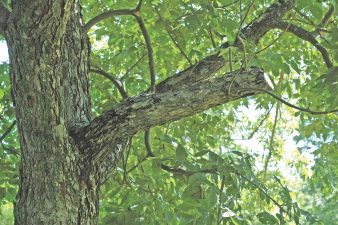
Natural limb pruning
When visitors come to this corner of Southeast Kansas and walk in the shade of our native pecan groves, they are most often impressed by the enormous size of the trees. One of the first questions that always pops into a visitors head is: “How do you prune these huge trees?” I explain that the...
Read more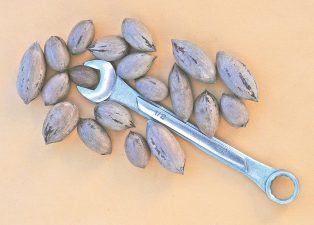
A Good Year to Mark Trees
The hot dry summers of 2011 and 2012 had a major impact on native pecan size and quality. In my area of Kansas, the dry weather shrank nuts down to about three quarters their normal weight. Fortunately, we received just enough late-summer rain during both years to promote full kernel development. By harvest, we were...
Read more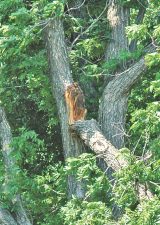
Identifying causes for trunk injuries
It’s mid-summer and there’s not much to do in the native grove except for clipping the ground cover. The other day I noticed a large limb had been ripped out of a native tree by the wind (Fig. 1). I thought to myself—“now that mess will be a hot job to clean up”. If you...
Read more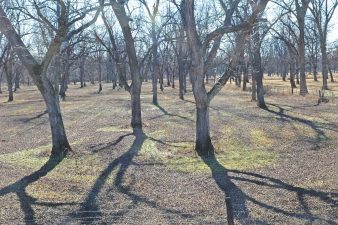
Consistent fertilization leads to consistent nut production
With the drop in prices paid for the 2012 native crop, growers are searching for ways to cut production costs this season. Unfortunately, one of the first production inputs many growers think about cutting is fertilizer. It all starts with a call to the local fertilizer dealer. Urea and potash are still both over $500...
Read moreDry weather lessons
The nuts produced in the northern portions of the pecan tree’s native range are known for having bright, high-quality kernels that provide the food industry with great tasting ‘topper-halves’. However, northern natives are not renowned for their large nut size. Over the past couple of years, region-wide droughts have had a major impact on our...
Read more
Weevils in their native environment
Weevil is the number one pest native pecan growers must learn to manage. Every time I think I’ve discovered the magic formula for completely stopping pecan weevil damage, nature throws me a curveball and I end up pulling weevil-damaged nuts off the cleaning table. It seems that managing pecan weevil in a native pecan grove may be...
Read more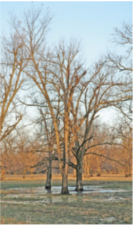
Working on Field Drainage
Last summer’s searing heat and bone dry conditions are still fresh in the minds of native pecan growers from Texas up through Kansas. However, it will not stay dry forever. The rains will return and we’ll soon be talking about cleaning up after a flood in the pecan grove. The fact is we can do...
Read moreTaking On More Natives
One thing’s certain in the pecan business. When pecan prices spike, more people get interested in managing native pecan trees. Drive through any native pecan area and you can find stands of trees that look to have potential for profitable pecan production. But looks can be deceiving. Some of these native stands were abandoned for...
Read moreWater and Native Pecans
Out here in the middle of the country, we’ve been under a dome of high pressure for weeks. Daily temperatures soar above 100 degrees and the sun is baking the field dry. It is even starting to get dry in our native pecan groves. At this point, even atheists are praying for rain. As most...
Read moreThe Other Pecan Product
The 2010 pecan crop set new records for prices paid to the producers of native pecans. With high prices comes renewed interest in developing new or long-time abandoned native pecan groves. Over the past few months, I’ve spent a lot of time working with landowners ready to get rich in the pecan game (oh, if...
Read moreNative Trees Recover from Ice Storm Damage
The older I get, the more respect I have for the durability of our native groves. Wind, floods, drought, freezing temperatures, and ice storms have all pummeled our native groves. But following every natural disaster, native groves recover and grow back into productivity. Sure, we lose some trees along the way, but our younger native...
Read moreNative Disease Management
Ever since the 2007 Easter freeze, it seems like we have had to re-adjust our thinking about pest management in native pecans, at least in the northern portion of the native pecan range. It seems like the freezing temperatures in the spring of 2007 not only destroyed all the emerging new shoots on our trees,...
Read moreA Walk In The Grove
It was a long cold winter. When the weather finally broke with a warm spell in mid-March, I decided to enjoy a moment of warm sunshine to walk the grove. This has become a sort of annual tradition with me, looking over the trees and reflecting on all the things we did right and all...
Read more